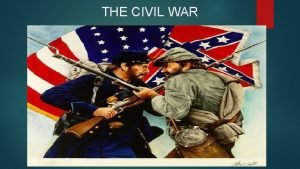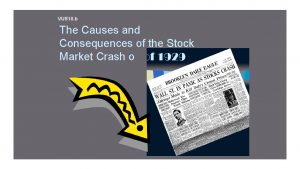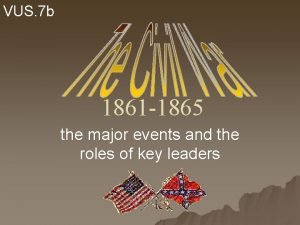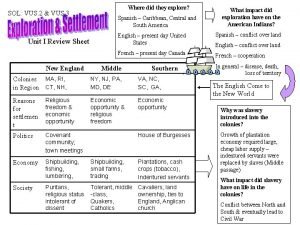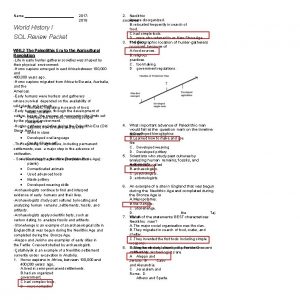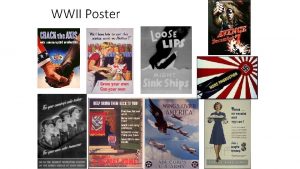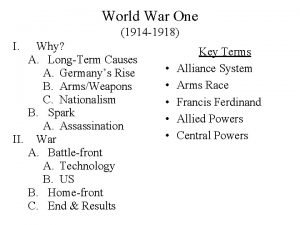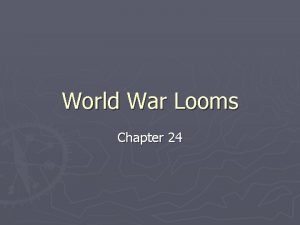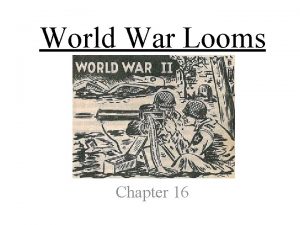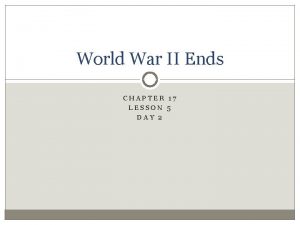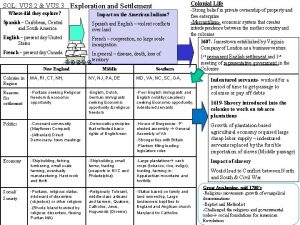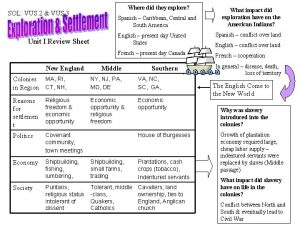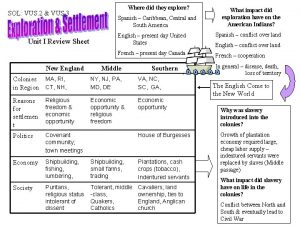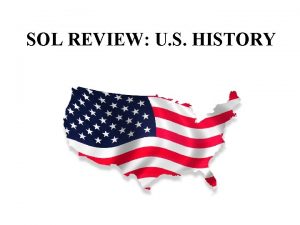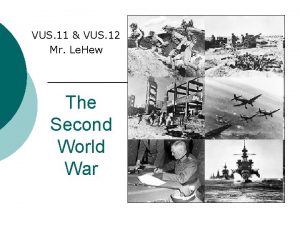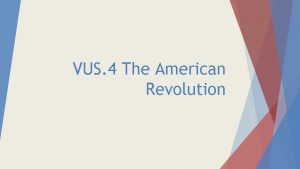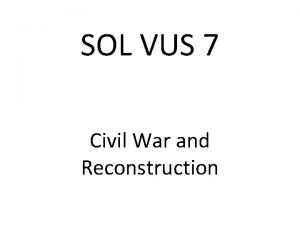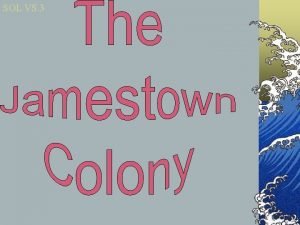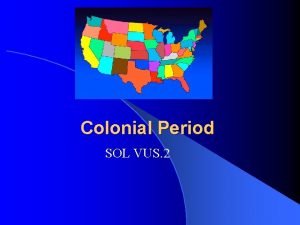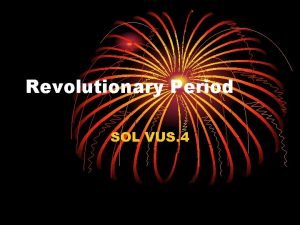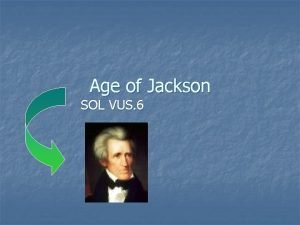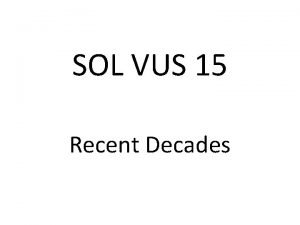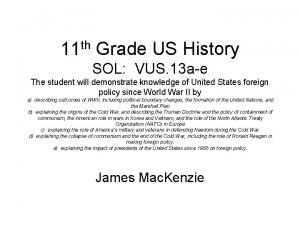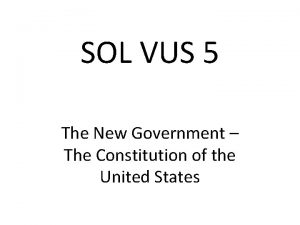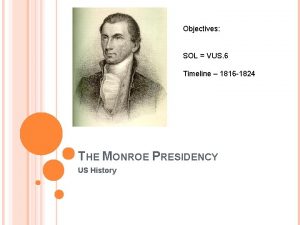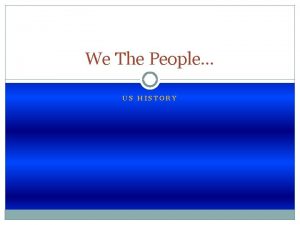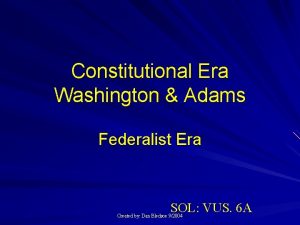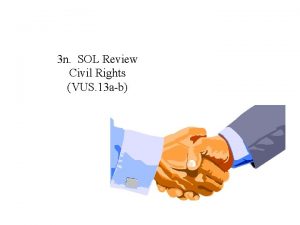World War II SOL VUS 10 The War


































































- Slides: 66

World War II SOL VUS. 10

The War In Europe

n WW II Began with Hitler’s Invasion of Poland in 1939. n Shortly after, Poland was invaded by the Soviet Union from the east and Baltic countries.

n. The United States remained neutral for the first two years.

Germany however, overran France and most of Europe and pounded Britain from the air during The Battle of Britain.

In 1941, Hitler turned on his former partner and invaded the Soviet Union.

Despite the strong isolationist sentiment at home, the United States increasingly helped Britain.

How did the United States Help? n By n In giving Britain war supplies and warships. return, The United States received military bases in Bermuda and the Caribbean.

The Lend Lease Act gave the President authority to sell or lend equipment to countries to defend themselves against the Axis powers.

President Roosevelt compared this Act to lending a garden hose to a neighbor whose house had caught fire.

The War in Asia

n During the 1930’s a militaristic Japan invaded and brutalized Manchuria and China as it sought military and economic domination over Asia. n The United States refused to recognize the Japanese conquest in Asia in the Stimson Doctrine and imposed an embargo on exports of oil and steel to Japan.

Tensions rose but both countries negotiated to avoid war.

Japan Attacks Pearl Harbor n While negotiations with the United States were going on and without any warning, Japan carried out an attack on the American Naval Base at Pearl Harbor in Hawaii on December 2, 1941.

n This attack destroyed much of the American Pacific fleet and killed several thousand Americans.

Roosevelt called this “a date that will live in infamy” as he asked Congress to declare war on Japan.

n After Pearl Harbor, Hitler honored a compact with Japan to declare war on the United States. n World War II was now an official world war, and the United States was fully involved.

s e i g e t a r t S Allied t ie v o S e h T d n a , America, Britain Union

Lets Talk Strategy! n America and its allies Britain and the Soviet Union followed a “Defeat Hitler First” strategy. n Most American military resources were targeted for Europe.

Island Hopping n In the Pacific, American military strategy called for an “island hopping” campaign, seizing islands closer and closer to Japan. n These islands were used as bases for air attacks on Japan. n They were also useful in cutting off supplies through submarine warfare against Japanese shipping

Axis Strategy

Germany’s Plan n Germany hoped to defeat the Soviet Union n Gain control of the Soviet Oil Fields n Force Britain out of the war through an air and submarine bombing campaign n This was supposed to happen before America’s military and industrial strength could turn the tide.

Japan’s Plan n Following Pearl Harbor, Japan invaded the Philippines and Indonesia. n They then planned to invade both Australia and Hawaii. n Its leaders hoped that America would then accept Japanese predominance in Southeast Asia and the Pacific, rather than conduct a bloody and costly war to reverse Japanese gains.

Famous WWII Battles In Africa

El Alamein German forces threatened to seize Egypt and the Suez Canal. They were defeated by the British. Egypt Suez Canal

This defeat at El Alamein prevented Hitler from gaining access to Middle Eastern oil supplies and potentially attacking the Soviet Union from the south.

Famous WWII Battles In Europe

Stalingrad n Hundreds of thousands of German soldiers were killed or captured in a months long siege of the Russian city of Stalingrad. n This defeat prevented Germany from seizing the Soviet oil fields and turned the tide against Germany in the east.

Normandy Landings (D-DAY) n Americans and Allied troops under Eisenhower landed in German occupied France on June 6, 1944. n Despite intense German opposition and heavy American casualties, the landing succeeded and the liberation of western Europe from Hitler had begun.

Famous WWII Battles The Pacific

Midway In the “Miracle of Midway, ” American naval forces defeated a much larger Japanese force as it prepared to seize Midway Island. n Coming only a few months after Pearl Harbor, a Japanese victory at Midway would have allowed the Japanese to invade Hawaii. n The American victory ended the threat to Hawaii and began a series of American victories in the “Island Hopping” campaign. n

Iwo Jima & Okinawa n The American invasion of the islands Iwo Jima & Okinawa, brought the American troops closer than ever to Japan. n Both invasions cost thousands of American lives as Japanese soldiers fought fiercely over every square inch of the islands. n Japanese soldiers and civilian committed suicide rather than surrendered.

The Use of the Atomic Bomb n If the Americans had to invade Japan, both Americans and Japanese would have suffered horrendous casualties. n President Truman ordered the use of atomic bombs on the Japanese cities of Hiroshima and Nagasaki to force the Japanese to surrender. Tens of thousands of people were killed in both cities.

Shortly after the bombs were used, the Japanese leaders surrendered. The need for American forces to invade Japan was avoided.

Minority Participation

World War II solidified the nation’s role as a global power and ushered in social changes and established reform agendas that would preoccupy public discourse in the U. S. for the remainder of the 20 th century.

Women entered into previously male job roles as African Americans and others struggled to obtain desegregation of the armed forces and end discriminatory hiring practices.

African Americans n Served in segregated military units and were assigned to non combat roles n Demanded the right to fight in combat rather than just playing support roles

Tuskegee Airman n African American n Served in Europe with distinction

Nisei Regiments Asian American n Earned a high number of decorations n

Additional Contributions of Minorities n Communication codes of the Navajo were used. These codes were oral and impossible for the Japanese to break. n Mexican Americans also fought, but in units that were not segregated. n Minority units suffered high casualties and won numerous unit citations and individual medals for bravery in action.

The Geneva Convention General Rules in the Treatment of Prisoners

What was the Geneva Convention? n Summit meeting between the nations involved in WWII n Attempted to ensure the humane treatment of POW’s by establishing rules to be followed by all nations.

The treatment of prisoners in the Pacific Theater often reflected the savagery of the fighting there. n In the Bataan Death March, American POW’s suffered brutal treatment by Japanese after the surrender of the Philippines. n Japanese soldiers often committed suicide rather than surrender.

The treatment of prisoners in Europe more closely followed the ideas of the Geneva Convention.

Specific groups were often the object of hatred and prejudice. During World War II , they faced increased risk of discrimination.

Genocide n The systematic and purposeful destruction of a racial, political, religious, or cultural group.

Final Solution Germany made the decision to exterminate all Jews. This began the Holocaust!

The Affected Groups Include: n n n Jews Poles Slavs Gypsies “Undesirables” – – – Homosexuals Mentally Ill Political Dissidents

Nuremburg Trials n Nazi leaders and others were convicted of war crimes. n Emphasized individual responsibility for actions during a war, regardless of orders received. n Led to an increased demand for a Jewish homeland.


1. What did the Lend Lease Act give the president the authority to do? To sell or lend equipment for countries to defend themselves From? The Axis powers

2. What did Franklin Roosevelt compare the Lend Lease Act to? Lending a garden hose to put out a house fire

3. What started World War II? Hitler’s invasion of Poland Who teamed with Hitler and also invaded Poland? The Soviet Union

4. What caused the U. S. to favor the Allied powers instead of remaining neutral? The Battle of Britain Hitler succeeded in taking France.

5. How did the U. S. react to Japan’s invasion of Manchuria? The U. S. enacted an embargo on the export of steel and oil to Japan. What doctrine refused recognition of Japan’s territorial gains? The Stimson Doctrine

6. What two actions prompted the U. S. to enter the war? 1. Japan attacked Pearl Harbor. 2. Hitler honored his pact to declare war on the United States.

7. Where did the Allied forces concentrate their efforts? Europe to defeat Hitler first. What was the strategy used in the Pacific called? Island hopping

8. What was the first thing the Axis wanted to accomplish? Defeat the Soviet Union and take their oil fields Why? They wanted to force Britain out of the war before America could turn the tide.

9. What important battle was fought in Africa? El Alamein – British victory prevented the capture of Middle East oil fields, the Suez Canal and Egypt Why was the Stalingrad battle important? This turned the tide in the east and prevented the capture of Soviet oil fields.

10. Why did Truman decide to use the atomic bomb? He felt it would shorten the war therefore lower casualties.

11. Match the following. Tuskegee Airmen Communication codes Navajo Marines Asian Americans Nisei regiments African Americans

12. What was the purpose of the Geneva Convention? To insure humane treatment of prisoners Give an example of the brutal treatment of prisoners. The Bataan Death March when U. S. soldiers were brutalized in the Philippines.

13. Why was the American victory on Okinawa important? It set the stage for an attack on Japan itself.

14. What were Germany’s leaders placed on trial for? Giving and following orders to commit war crimes

15. What invasion liberated France? The invasion at Normandy called the D -Day Invasion
 Confederate surrender day
Confederate surrender day Greyhound vus
Greyhound vus Vus.10b when was the stock market crash?
Vus.10b when was the stock market crash? Vus 7a what event sparked secession of the southern states?
Vus 7a what event sparked secession of the southern states? Vus review
Vus review Contoh sol koloid
Contoh sol koloid World history 1 sol review
World history 1 sol review Hình ảnh bộ gõ cơ thể búng tay
Hình ảnh bộ gõ cơ thể búng tay Ng-html
Ng-html Bổ thể
Bổ thể Tỉ lệ cơ thể trẻ em
Tỉ lệ cơ thể trẻ em Chó sói
Chó sói Tư thế worm breton
Tư thế worm breton Chúa yêu trần thế alleluia
Chúa yêu trần thế alleluia Các môn thể thao bắt đầu bằng tiếng đua
Các môn thể thao bắt đầu bằng tiếng đua Thế nào là hệ số cao nhất
Thế nào là hệ số cao nhất Các châu lục và đại dương trên thế giới
Các châu lục và đại dương trên thế giới Cong thức tính động năng
Cong thức tính động năng Trời xanh đây là của chúng ta thể thơ
Trời xanh đây là của chúng ta thể thơ Mật thư tọa độ 5x5
Mật thư tọa độ 5x5 Phép trừ bù
Phép trừ bù Phản ứng thế ankan
Phản ứng thế ankan Các châu lục và đại dương trên thế giới
Các châu lục và đại dương trên thế giới Thơ thất ngôn tứ tuyệt đường luật
Thơ thất ngôn tứ tuyệt đường luật Quá trình desamine hóa có thể tạo ra
Quá trình desamine hóa có thể tạo ra Một số thể thơ truyền thống
Một số thể thơ truyền thống Bàn tay mà dây bẩn
Bàn tay mà dây bẩn Vẽ hình chiếu vuông góc của vật thể sau
Vẽ hình chiếu vuông góc của vật thể sau Thế nào là sự mỏi cơ
Thế nào là sự mỏi cơ đặc điểm cơ thể của người tối cổ
đặc điểm cơ thể của người tối cổ Thế nào là giọng cùng tên
Thế nào là giọng cùng tên Vẽ hình chiếu đứng bằng cạnh của vật thể
Vẽ hình chiếu đứng bằng cạnh của vật thể Vẽ hình chiếu vuông góc của vật thể sau
Vẽ hình chiếu vuông góc của vật thể sau Thẻ vin
Thẻ vin đại từ thay thế
đại từ thay thế điện thế nghỉ
điện thế nghỉ Tư thế ngồi viết
Tư thế ngồi viết Diễn thế sinh thái là
Diễn thế sinh thái là Dot
Dot Các số nguyên tố là gì
Các số nguyên tố là gì Tư thế ngồi viết
Tư thế ngồi viết Lời thề hippocrates
Lời thề hippocrates Thiếu nhi thế giới liên hoan
Thiếu nhi thế giới liên hoan ưu thế lai là gì
ưu thế lai là gì Hổ sinh sản vào mùa nào
Hổ sinh sản vào mùa nào Khi nào hổ con có thể sống độc lập
Khi nào hổ con có thể sống độc lập Hệ hô hấp
Hệ hô hấp Từ ngữ thể hiện lòng nhân hậu
Từ ngữ thể hiện lòng nhân hậu Thế nào là mạng điện lắp đặt kiểu nổi
Thế nào là mạng điện lắp đặt kiểu nổi James madison war at home
James madison war at home Korean war vietnam war venn diagram
Korean war vietnam war venn diagram The cold war begins lesson 1
The cold war begins lesson 1 Truman vs eisenhower venn diagram
Truman vs eisenhower venn diagram Why was josette dugas for the war of 1812
Why was josette dugas for the war of 1812 Ich war, du warst
Ich war, du warst Studyjams force and motion
Studyjams force and motion Civil war first modern war
Civil war first modern war Perfect lizz
Perfect lizz Toward civil war lesson 3 secession and war
Toward civil war lesson 3 secession and war Proxy war cold war definition
Proxy war cold war definition Chapter 30 the war to end war
Chapter 30 the war to end war Chapter 30 the war to end war
Chapter 30 the war to end war Bandwagon poster
Bandwagon poster Results of the world war 1
Results of the world war 1 Gbyeg
Gbyeg Chapter 16 building vocabulary world war looms
Chapter 16 building vocabulary world war looms Lesson 5 world war ii ends
Lesson 5 world war ii ends
